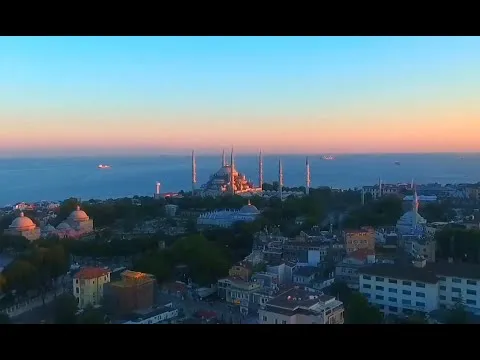
Dear Steemit Friends:
On my adventures with you today we're going to explore Sultan Ahmed Mosque, located in Istanbul, Turkey. You will see that this mosque is not only impressive for its sheer size but also its beauty. It still functions as a busy centre for religion with thousands visiting daily for their prayers.
First build between 1609 and 1616 by Sultan Ahmed the 1st, Sultan of the Ottoman empire from 1603 - 1617. Ahmed I first came to the thrown of the Ottoman empire when he was just thirteen years old and was born to Sultan Mehmed the 3rd. At the time, it was common for the eldest son to take the thrown after his father and then kill all of his brothers so he no longer had competition. Ahmed I was the first Sultan to break this 'tradition' by leaving his brother alive.
He reigned for just 14 years but the Sultan Ahmed Mosque still stands today as his lasting legacy to the world and the Islamic faith. Otherwise known as The Blue Mosque, it is one of the largest in the world. The nickname of 'Blue Mosque' comes from the hand painted blue tiles that line the inside of the walls, which you will soon see with me, as well as now being lit with blue lights at night.
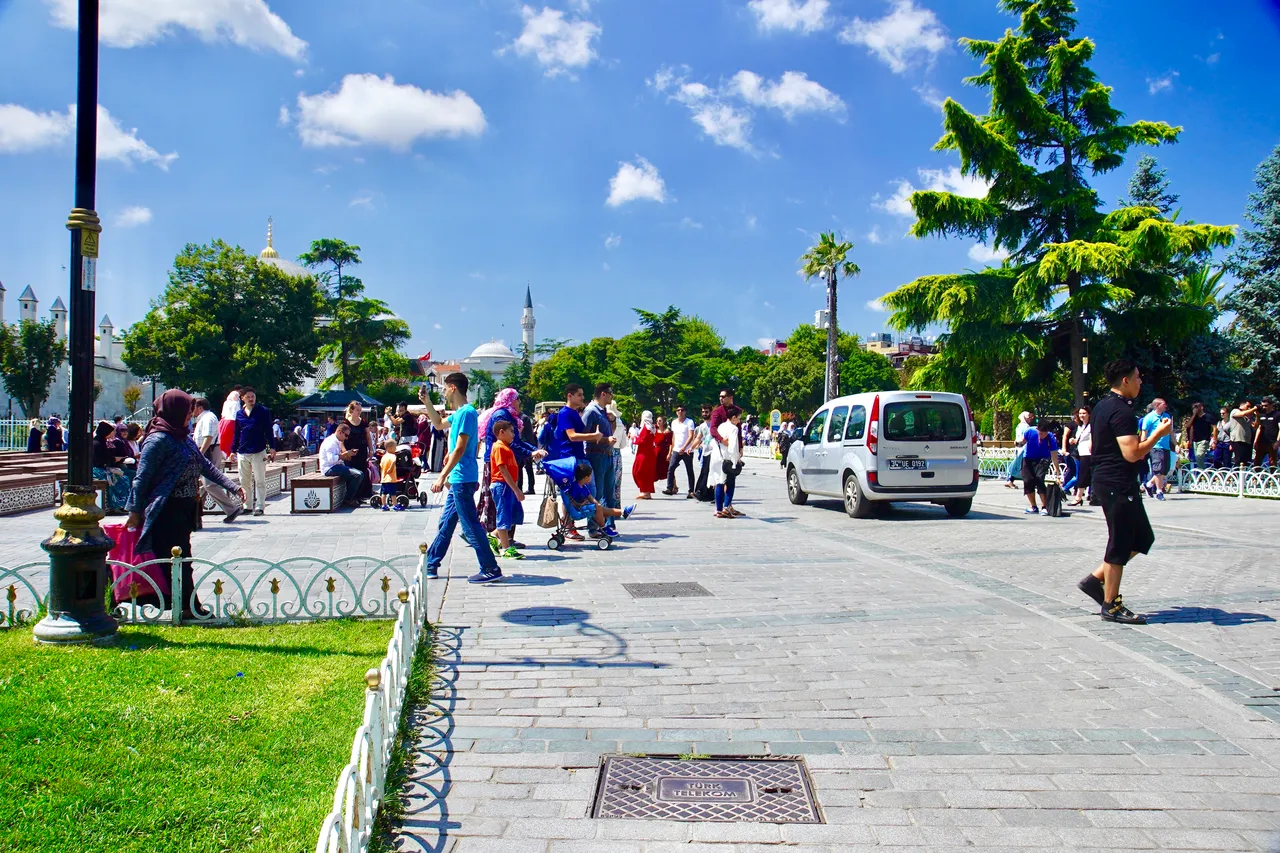
The Sultan Ahmed Mosque is an extremely popular tourist destination, as you can see here. Millions flock to the impressive structure each year, to experience the grandeur and architecture and of course also for religious reasons.

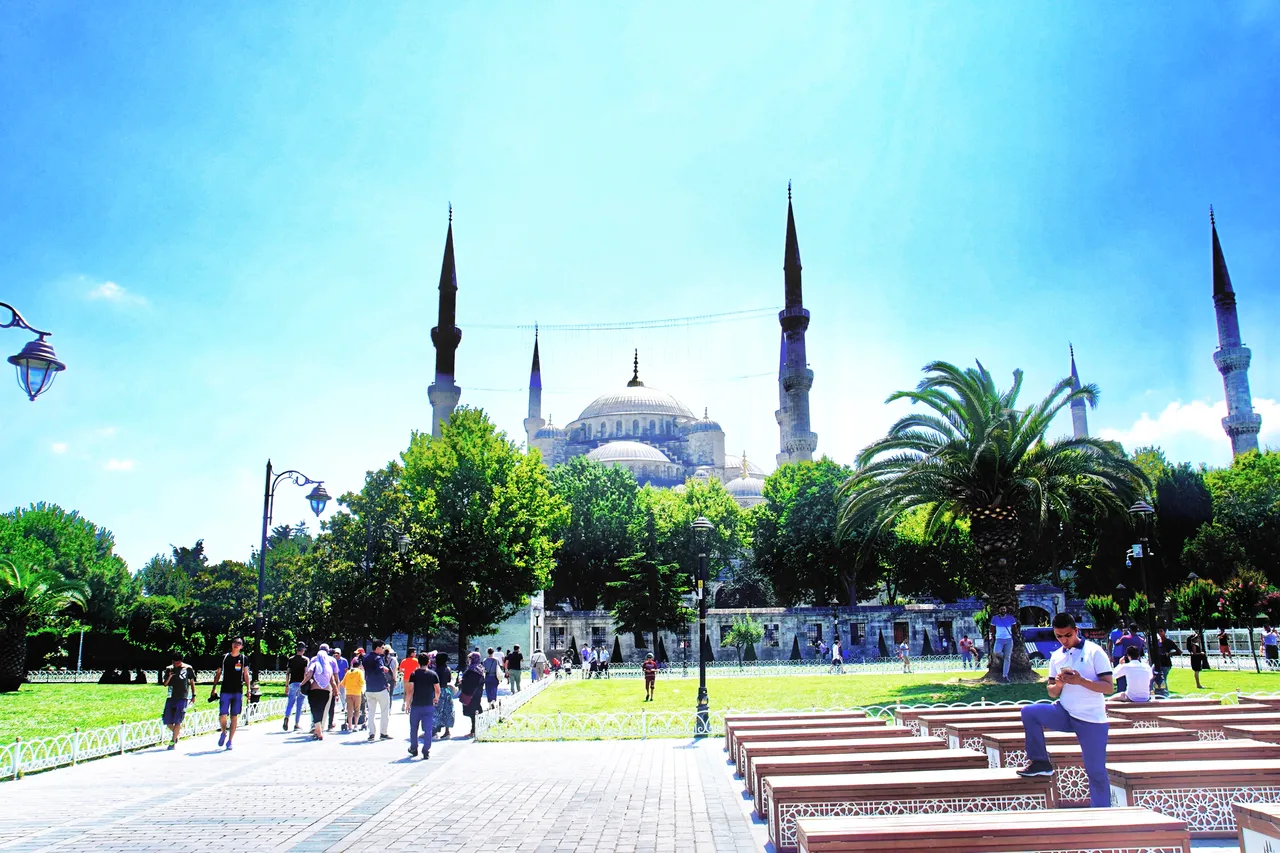
I couldn't wait to start exploring. The mosque is absolutely huge - it has a capacity of 10,000 people and its largest dome stands 43m high into the sky with the tallest minarets (towers) being 64m high. The Blue Mosque has five main domes with six towers called minarets. There are also another eight smaller domes on the structure. There is an interesting history to the minarets. According to a little bit of legend, the original architect thought that the sultan had asked for six (altı) minarets when he actually said gold (altın) minarets. An easy mistake to make when you look at the words from the original language.
This presented a major problem because the only other mosque in the world that has six minarets is the Prophet's mosque in Mecca. Ahmed I felt that this was a serious insult so remedied the situation by building a 7th minaret in the Prophet's mosque.
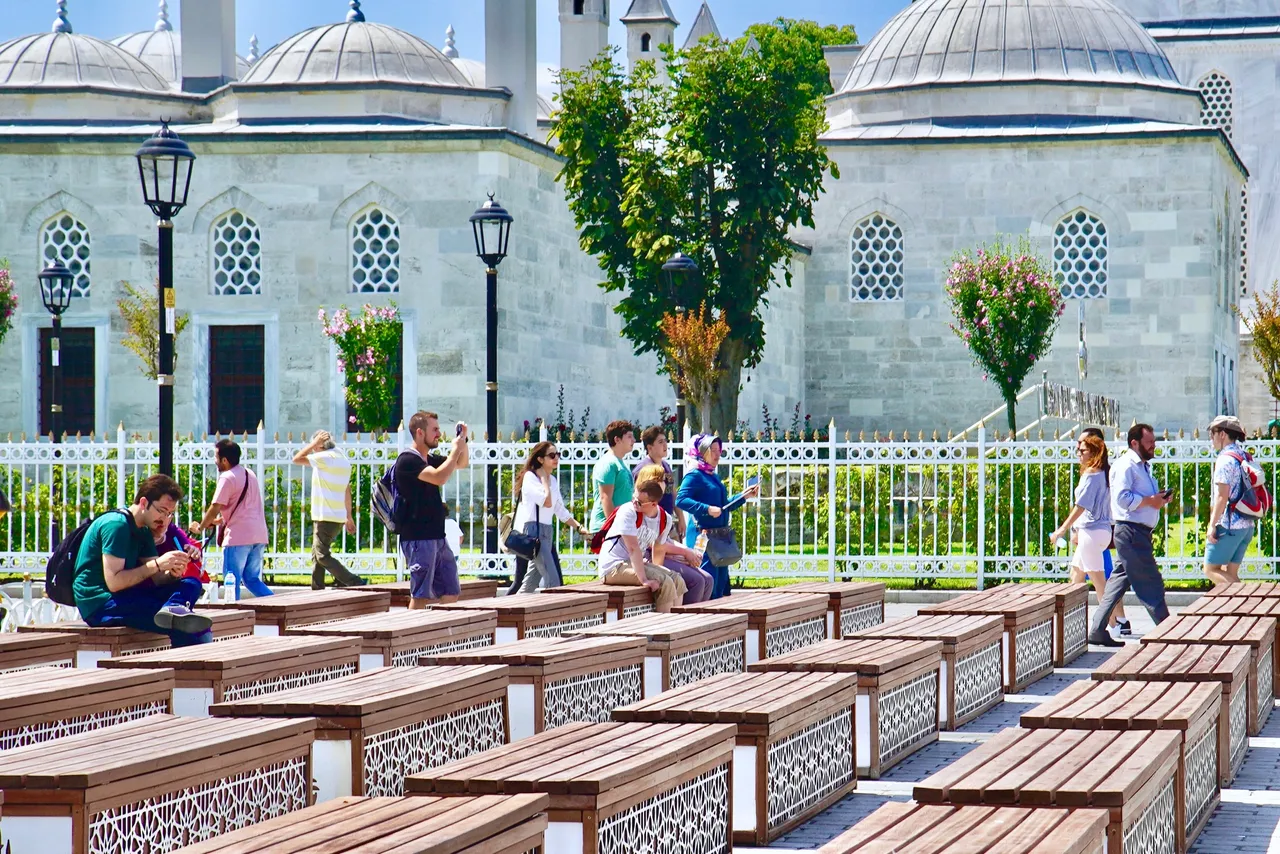
The grounds around the mosque are beautifully maintained, creating a wonderful contrast between the grandeur of the building and the greenery of nature, tamed and manicured by man. It's good that there was plenty of space around the building because there were thousands of people visiting and it meant it didn't feel too crowded. As I approached in awe, I felt ready to enter what I had been told was one of the most beautiful buildings in the world.
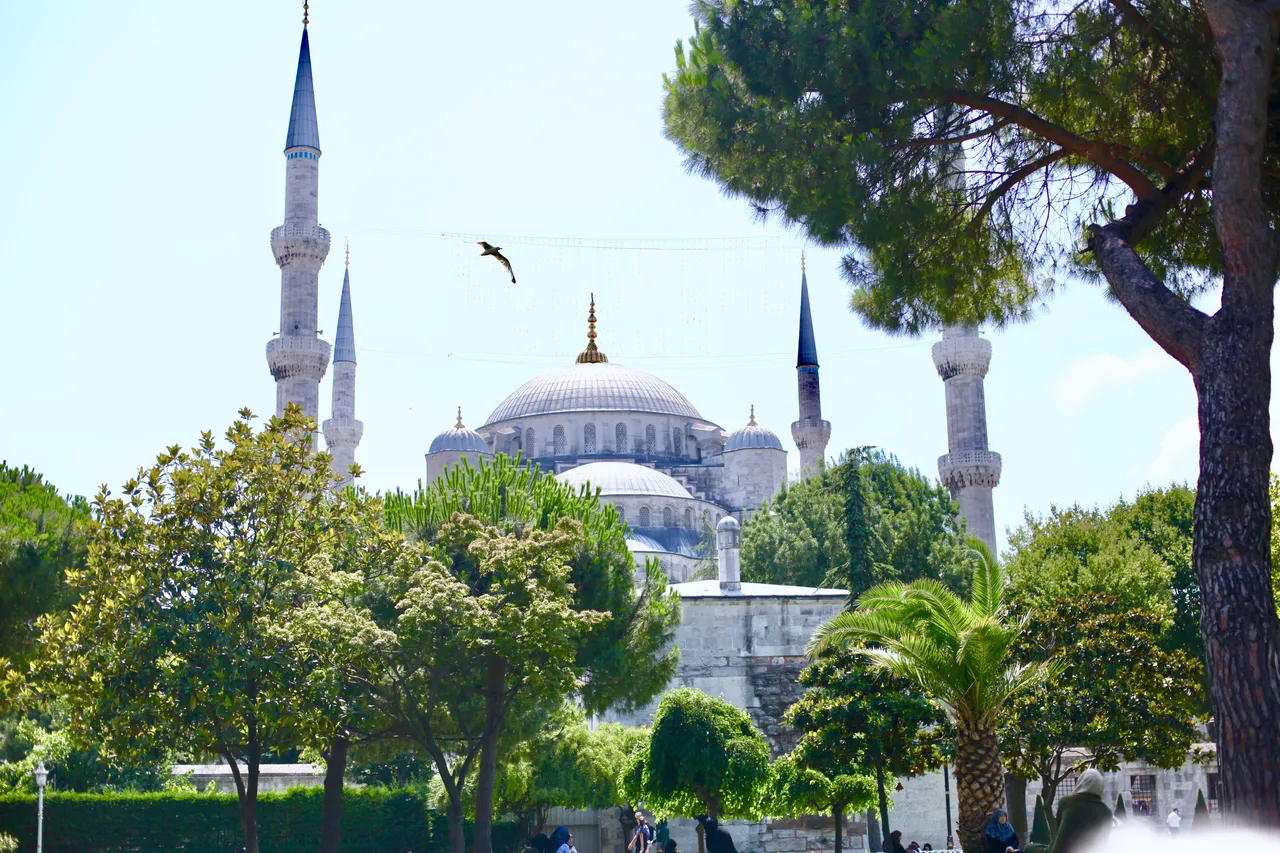
Entrance to the forecourt of the Blue Mosque
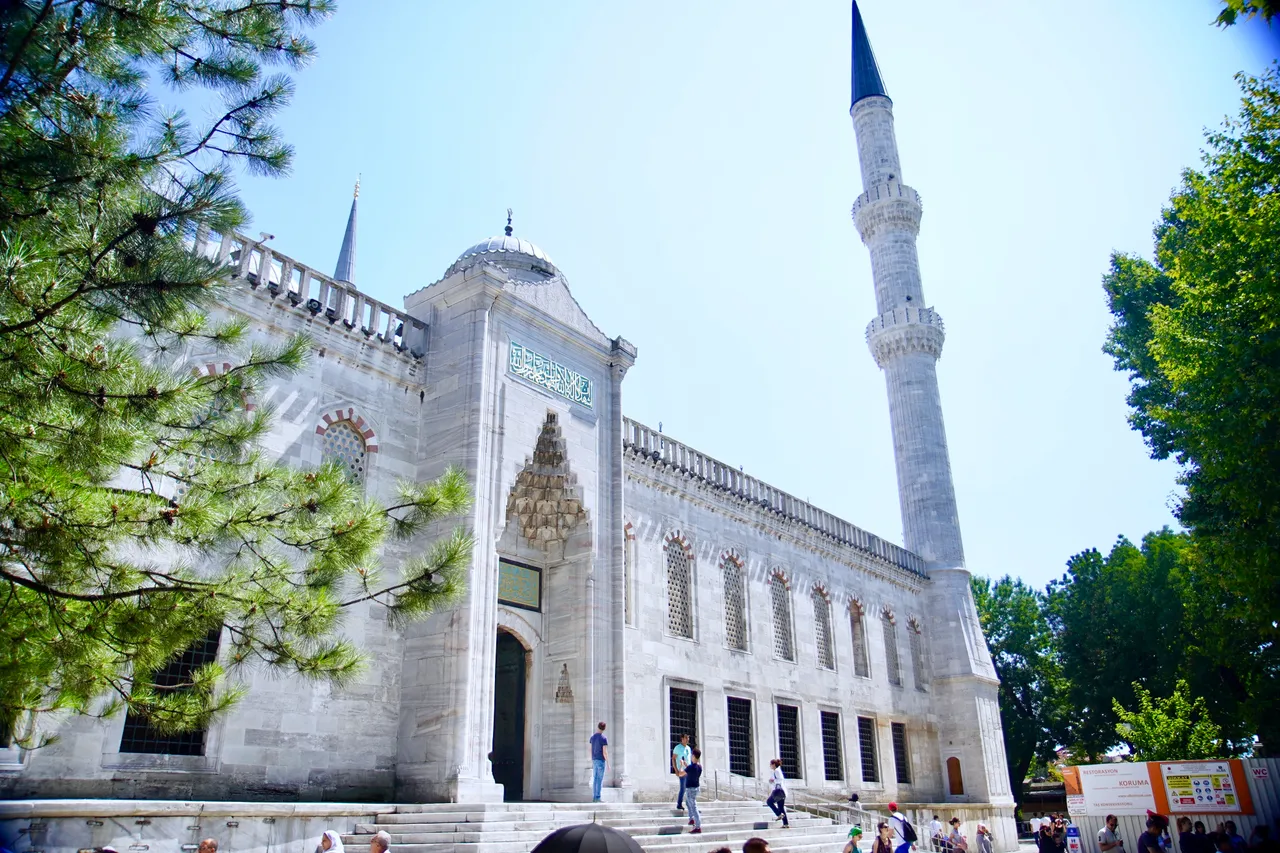
At front of Sultan Ahmed Mosque is a large forecourt, which is actually about the same size as the mosque all over again. Surrounding the forecourt runs a covered arcade and in the centre lies a small fountain. You can see that even this outer wall of the forecourt is impressive, with its large minarets on each corner.


Architecturally, the entrance is very unique. You can see this amazing inverted stone work, made with geometric shapes. I was so in awe and I hadn't even entered yet! On the western entrance to the forecourt there was a chain hanging across the entrance. Historically, only the Sultan was allowed to ride on horse back into the court and the chain was hung in such a way that he would have to duck while riding on horse back. It was a sign of respect and humility that even though he could ride on horse back he would still bow when entering this holy place.

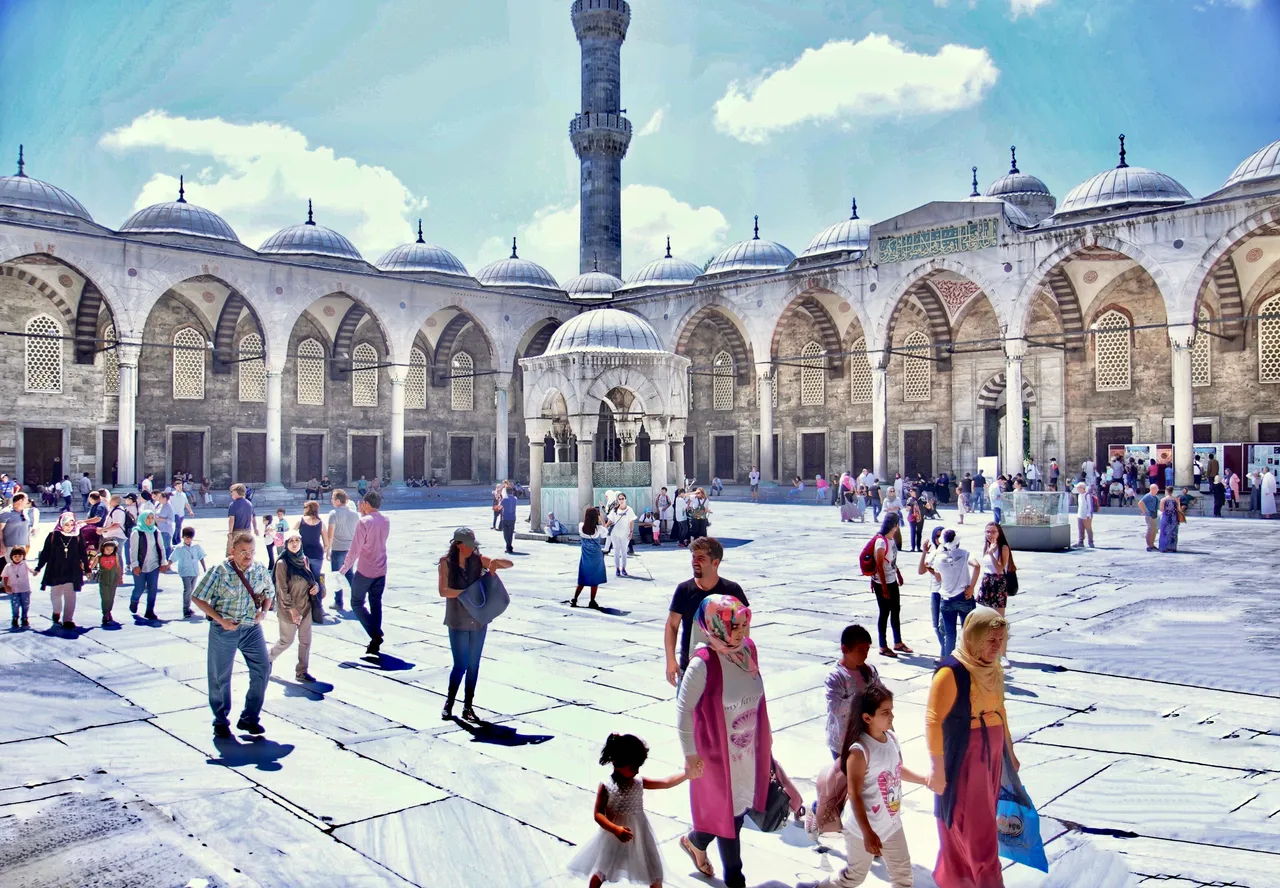

The spectacular interior of Sultan Ahmed Mosque
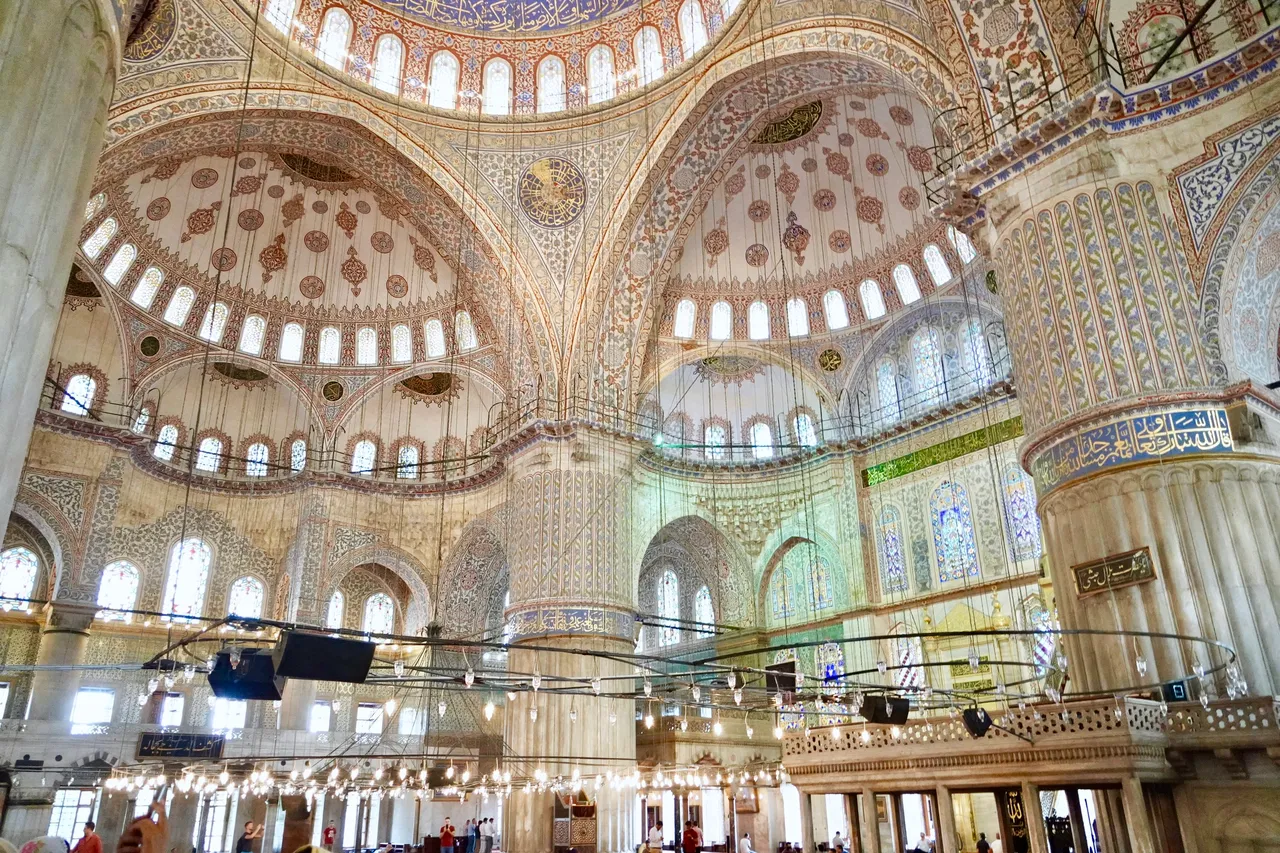
If you thought the outside of the mosque was impressive, wait until you see the inside. There were so many aspects of the inside that caused my jaw to drop. First, I didn't expect nearly the entire interior to be the size as the exterior - I had thought there would be a few small rooms inside the impressive dome. But in fact, it was just one large vaulted space. I felt so small under the enormity of the cavernous space.
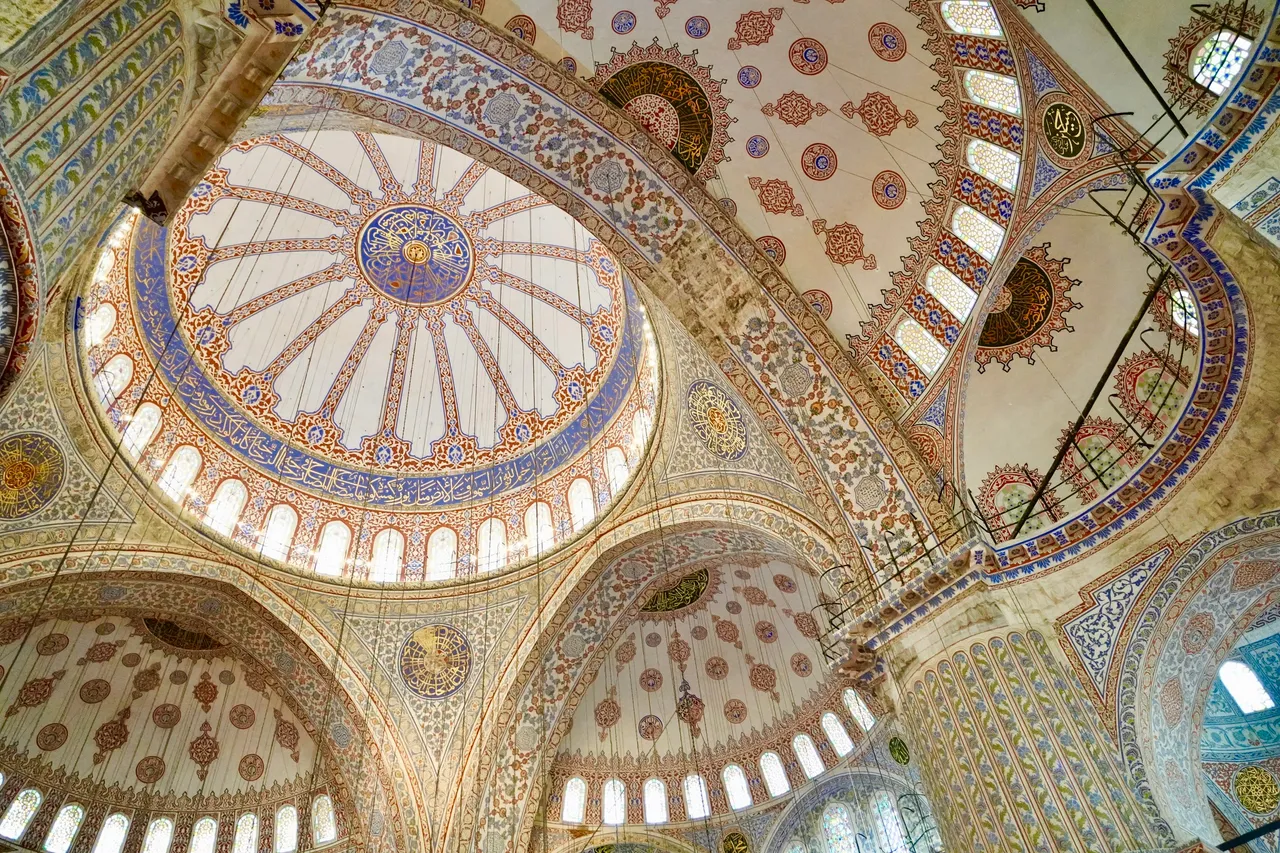
However, the real jaw dropper is the mosaic tiles all over the inside of the domes. Every column, every vault, every dome has thousands of tiny tiles all over them in intricate patterns. There are over 20,000 hand made tiles in the Iznik style, a famous style of ceramic design from the town of Iznik in my beloved Anatolia Region of Turkey.
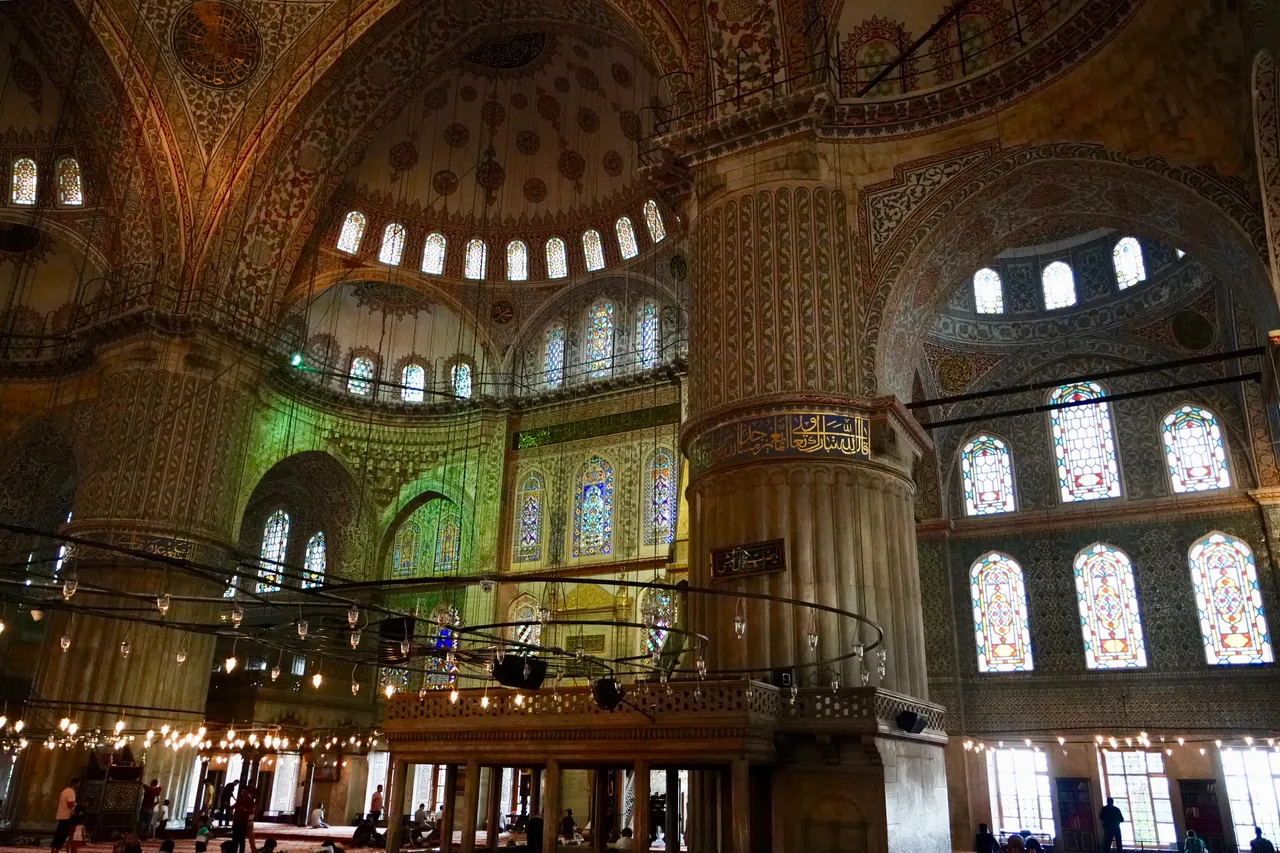
In the higher levels of the central rooms are found over 200 stained glass windows which admit plenty of daylight, illuminated the beautiful, predominantly blue paint, of the tile work. I have to say, and I hope you can tell why from the pictures, I was completely in awe. Have you ever had one of those moments where your mind cannot seem to understand what your eyes are seeing? That's what it felt like for me. I just couldn't believe what I was seeing.

Inside, there is of course a very important dress code to show good levels of respect. The head, arms and legs must be covered and the mosque supplies anyone who doesn't have the right clothing with something they can put on during their visit. As with all active mosques, prayers take place five times per day and as a result the place is closed for thirty minutes during each of these times. The rest of the time, however, it's still important to show respect for the religious significance of the building.

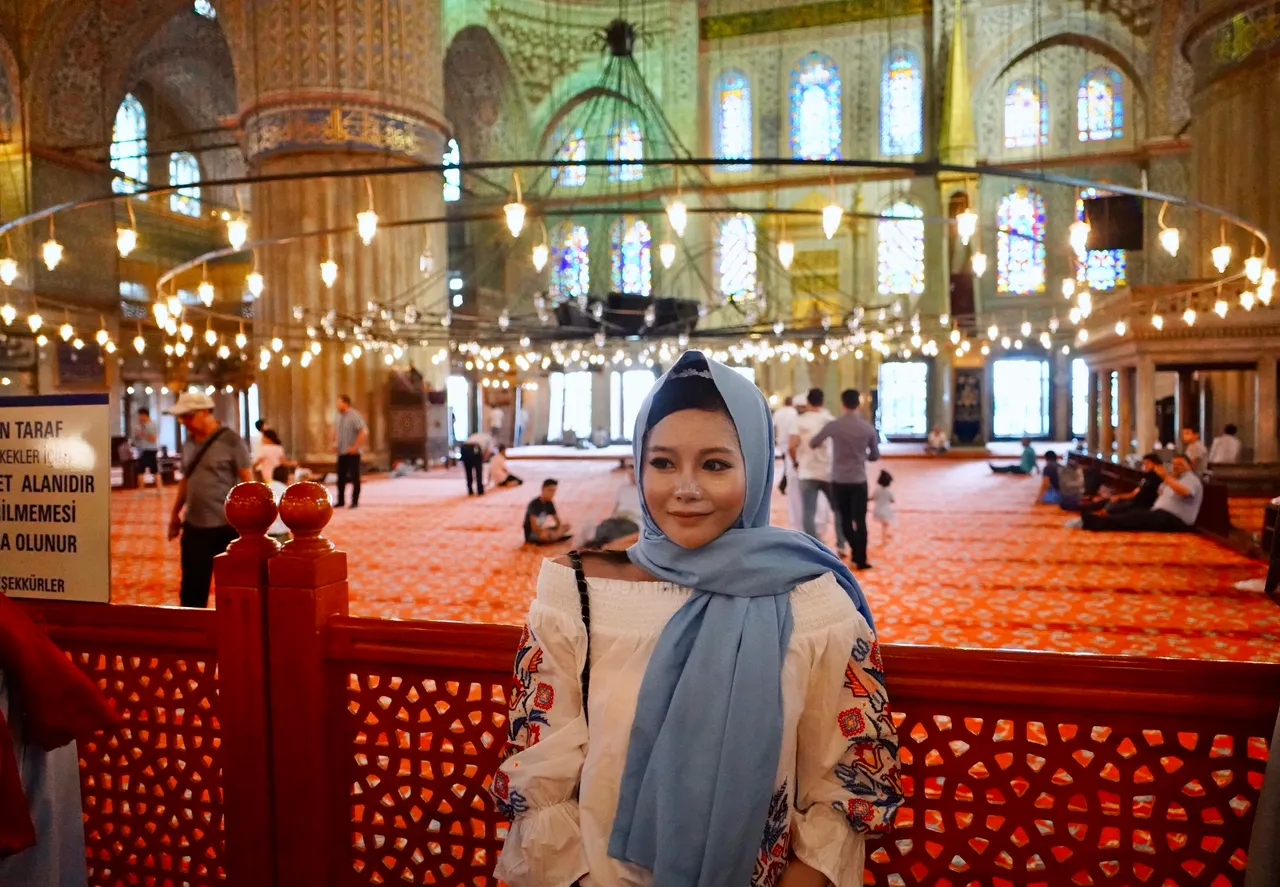
The plush carpet keeps the ground soft for those praying within the mosque and was as elaborate and beautiful in its design as the walls and ceiling. It also softens a lot of the sounds and echos that you sometimes get in buildings of this magnitude, giving it an air of solemnity and importance. It just felt quiet and imposing, is a building of this significance should feel.
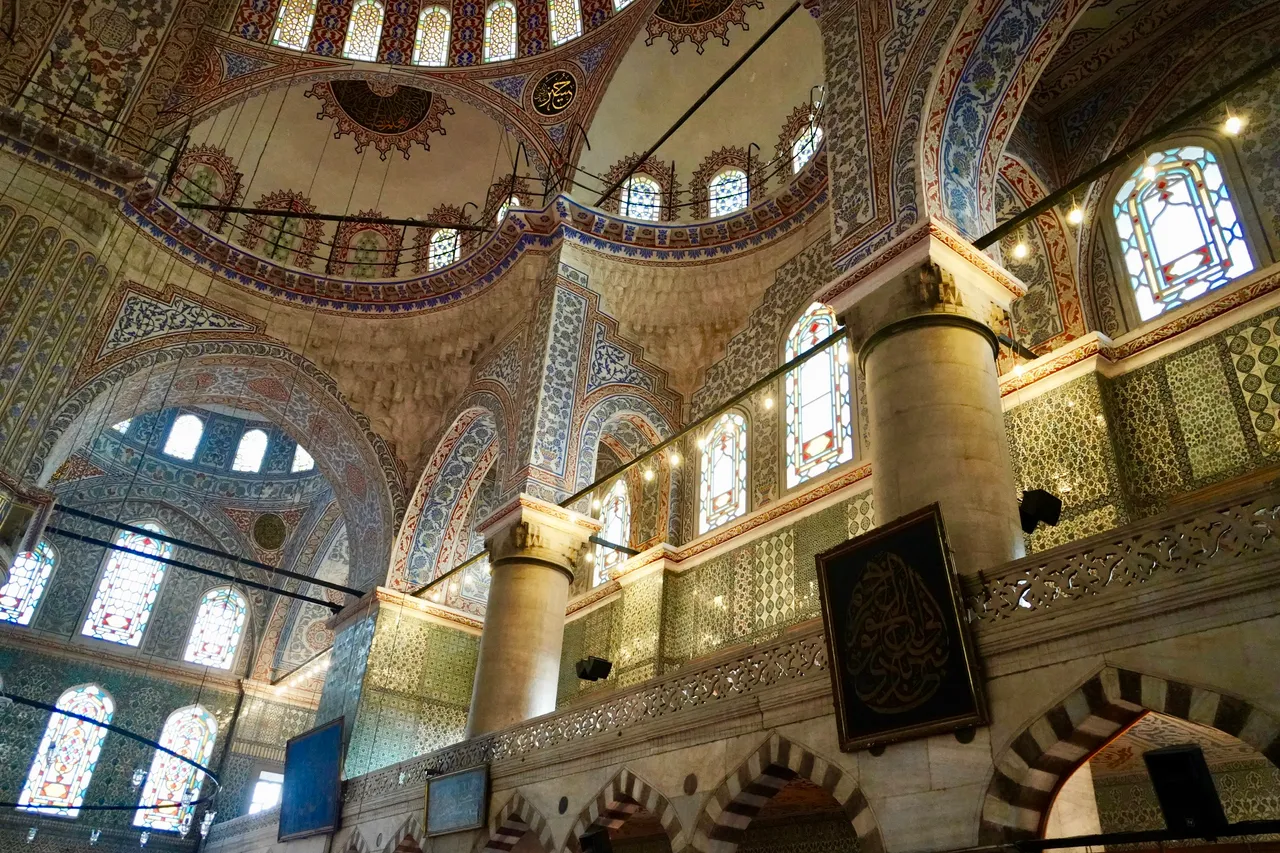
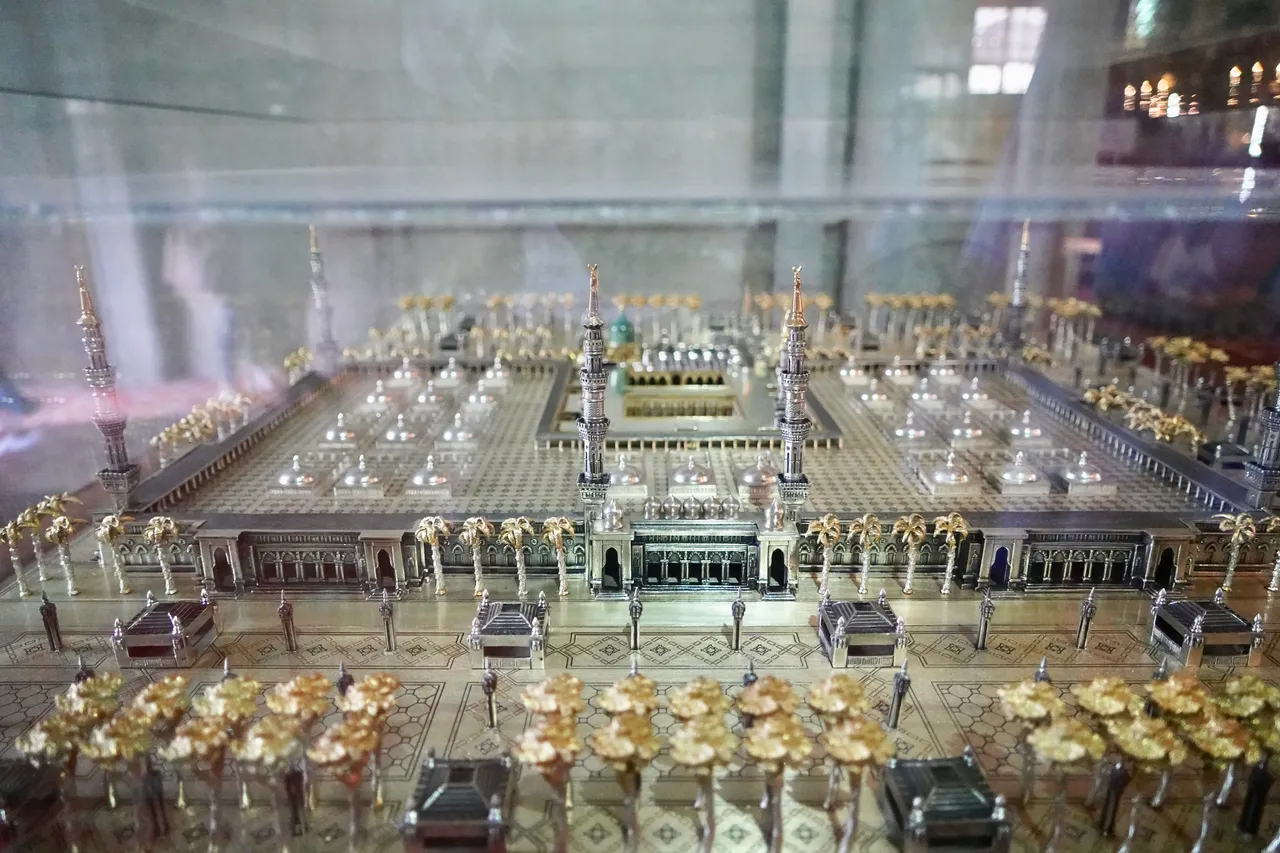

The water storage cisterns below Istanbul
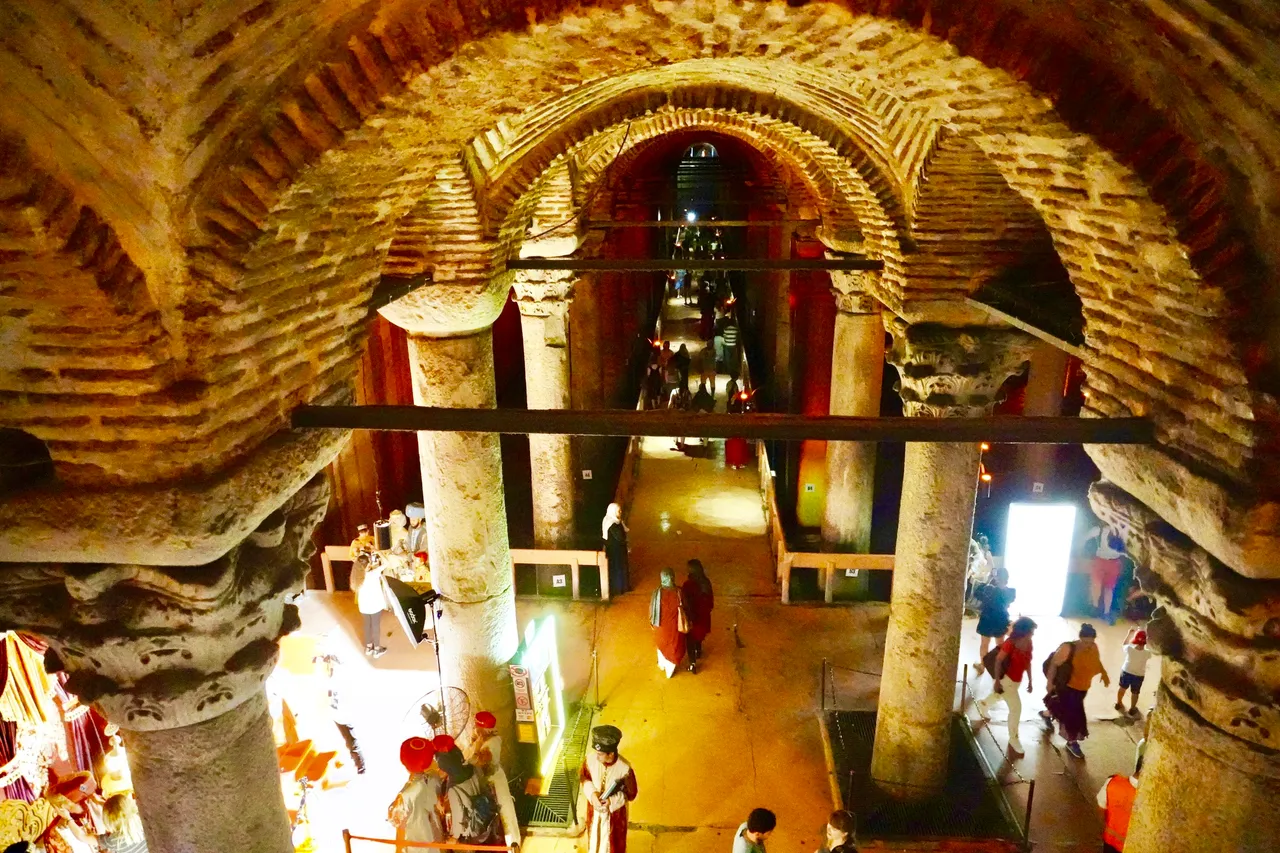
Just a few hundred meters away from the Blue Mosque, underneath the stones of the city streets, you find the Basilica Cistern. Below the city of Istanbul there are hundreds of ancient cisterns for storing rain water. These structures were built in the 6th century by the Later Roman Empire or the Byzantine Empire for storing water in the notoriously hot summers in Turkey.
Located under the previous site of a giant Basilica, that's how this particular cistern got its name. Unfortunately the basilica which once stood above the Basilica Cistern has long since gone. However, the marvel that stands below it, is as impressive as many buildings above ground. Apparently over 7,000 slaves were used to construct this one cistern alone, which is one of the largest in Istanbul and particularly well preserved and maintained.
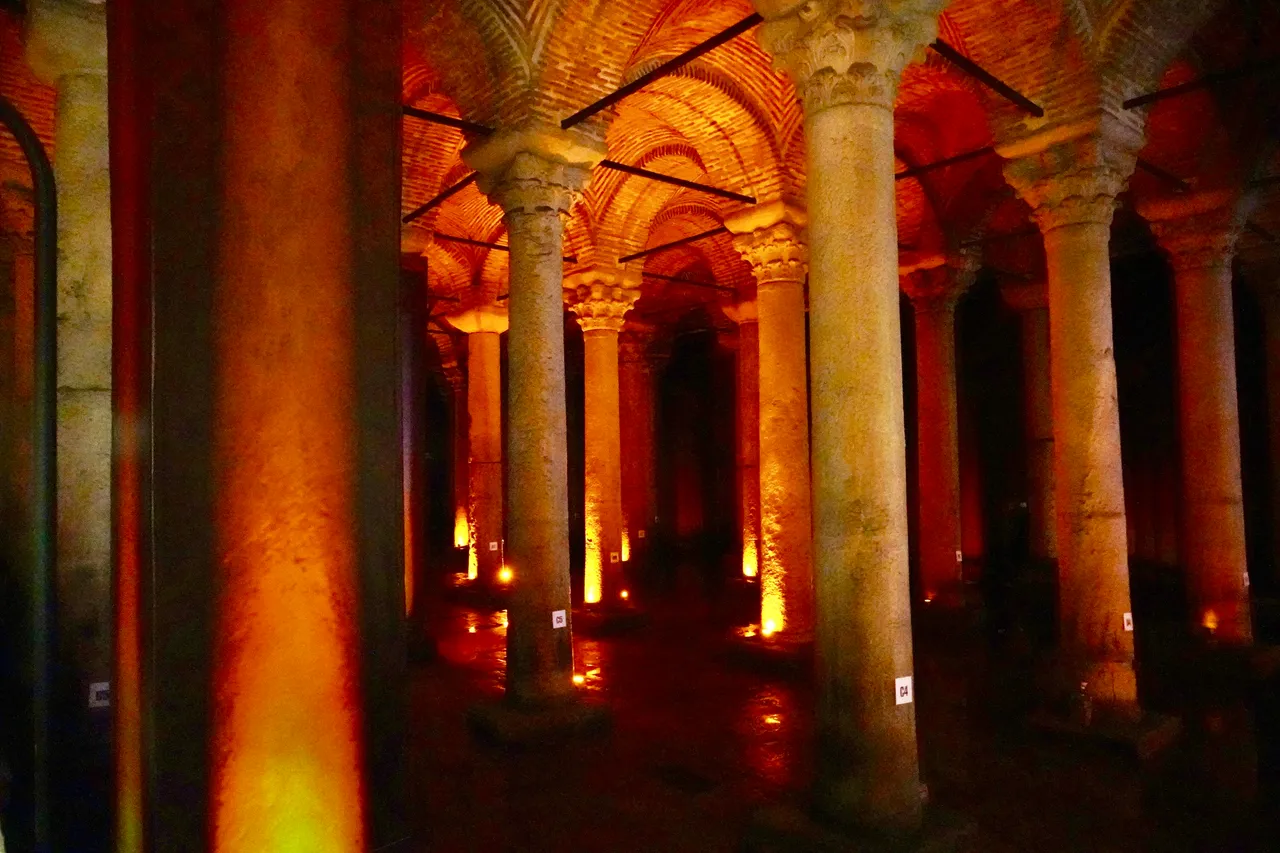
The cisterns were built to provide drinking water for the grand palace of Istanbul, or Constantinople as the city was known at the time that the cisterns were built. I was astounded by the feat of engineering that it must have taken to create this incredible structure. 138 meters long and 65 meters wide, the space could probably have fit the entire Sultan Ahmed Mosque inside it. The statistics I saw within the Basilica Cistern suggested that it could hold 80,000 cubic meters of water - that's a lot!

Holding up the impressive, beautiful and practical ceiling were hundreds upon hundreds of columns. There were over three hundred, with there being twelve rows of twenty eight columns in each row. It was like walking through a forest of human ingenuity and endeavour. I just couldn't believe the extent of the work that must have gone into this most practical of systems. Each outer wall is over four meters thick and then coated with a waterproof mortar to keep the water in.

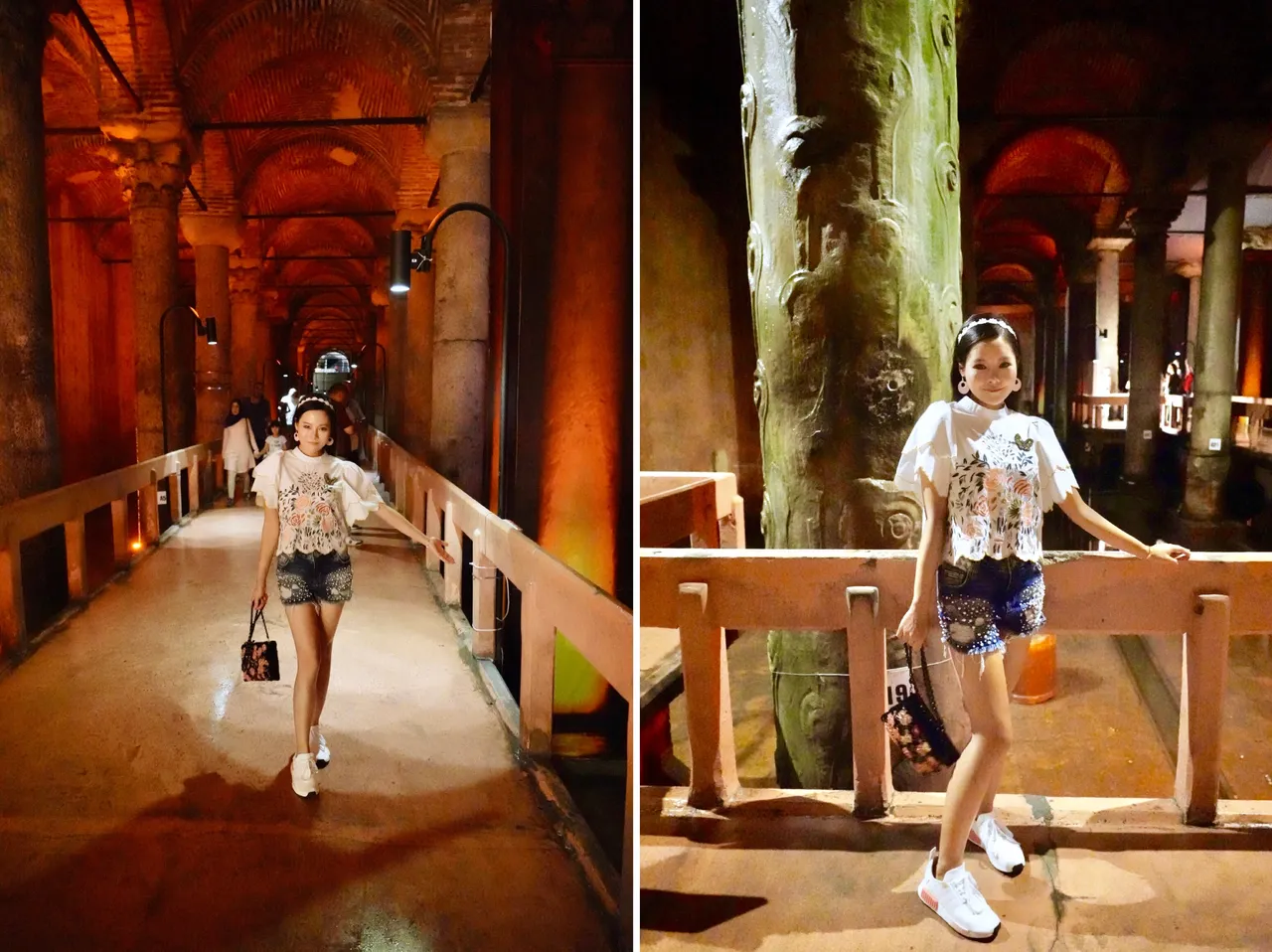
Walking down the fifty two steps into the cool of the cistern was quite creepy. The water would have been topped up via an aqueduct, an ancient way of transporting water. Nowadays, there is still some water in here but it's mostly naturally occurring from rain water and isn't allowed to fill up to the top like in the past - because there's tourists like me visiting! Since it can store 100,000 tons of water, I was glad it was quite empty or I would have been very wet.
The platforms built here were put in during a restoration project in 1985 when 50,000 tonnes of mud was removed, though before these walk ways you could visit via boat. Though less people could visit this way, it would have been quite the experience to take a boat around the underground cistern - an opportunity I am sad to have missed. Non-the-less the cistern has been officially opened to the public for over 30 years now and I'm so glad because it's a real marvel of the human spirit.
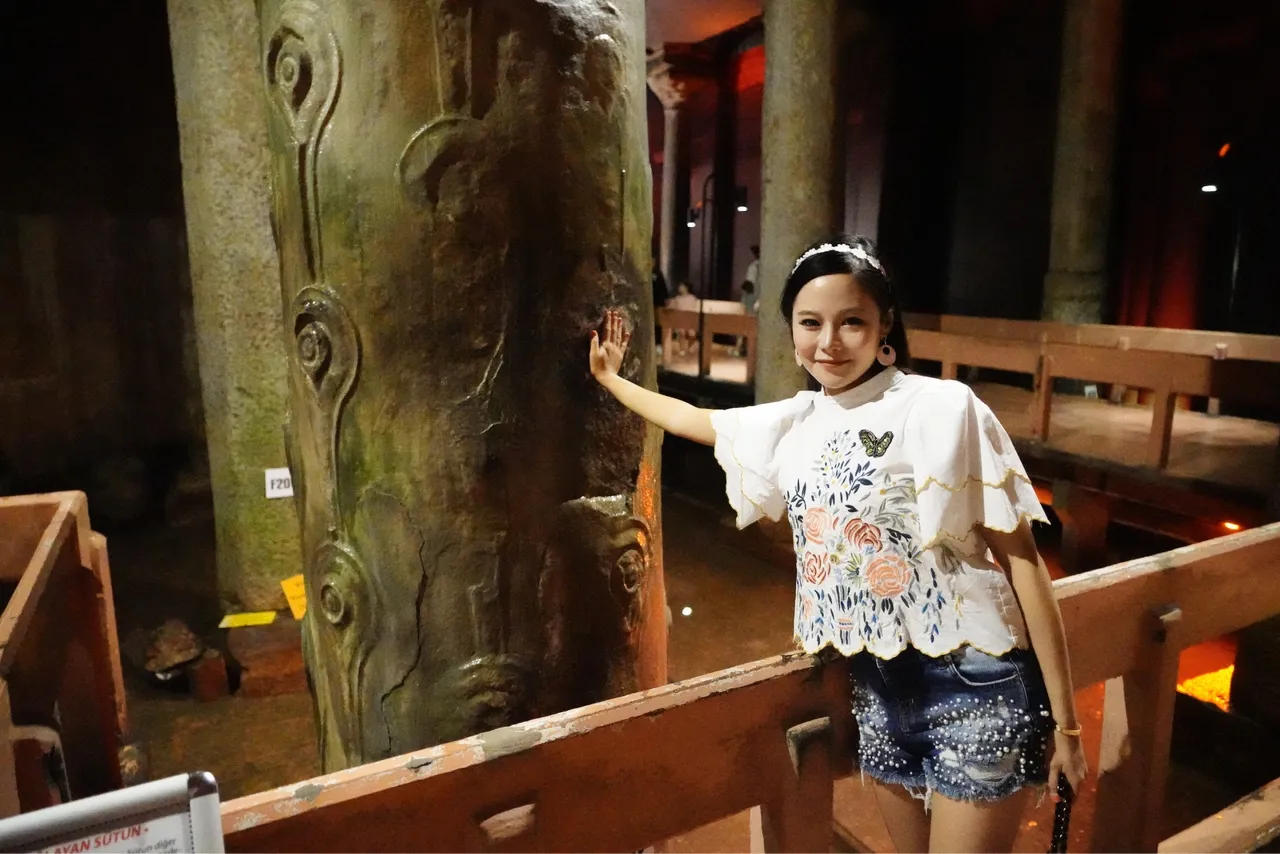
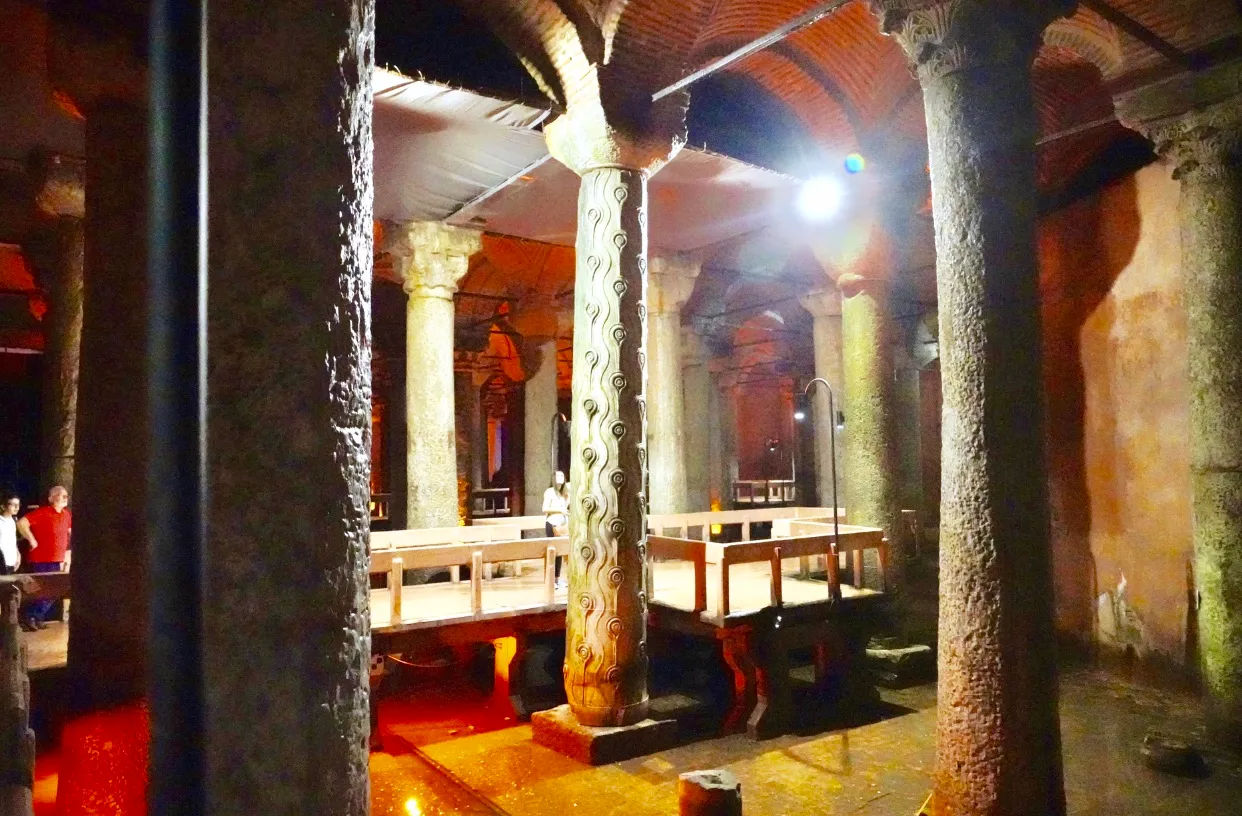
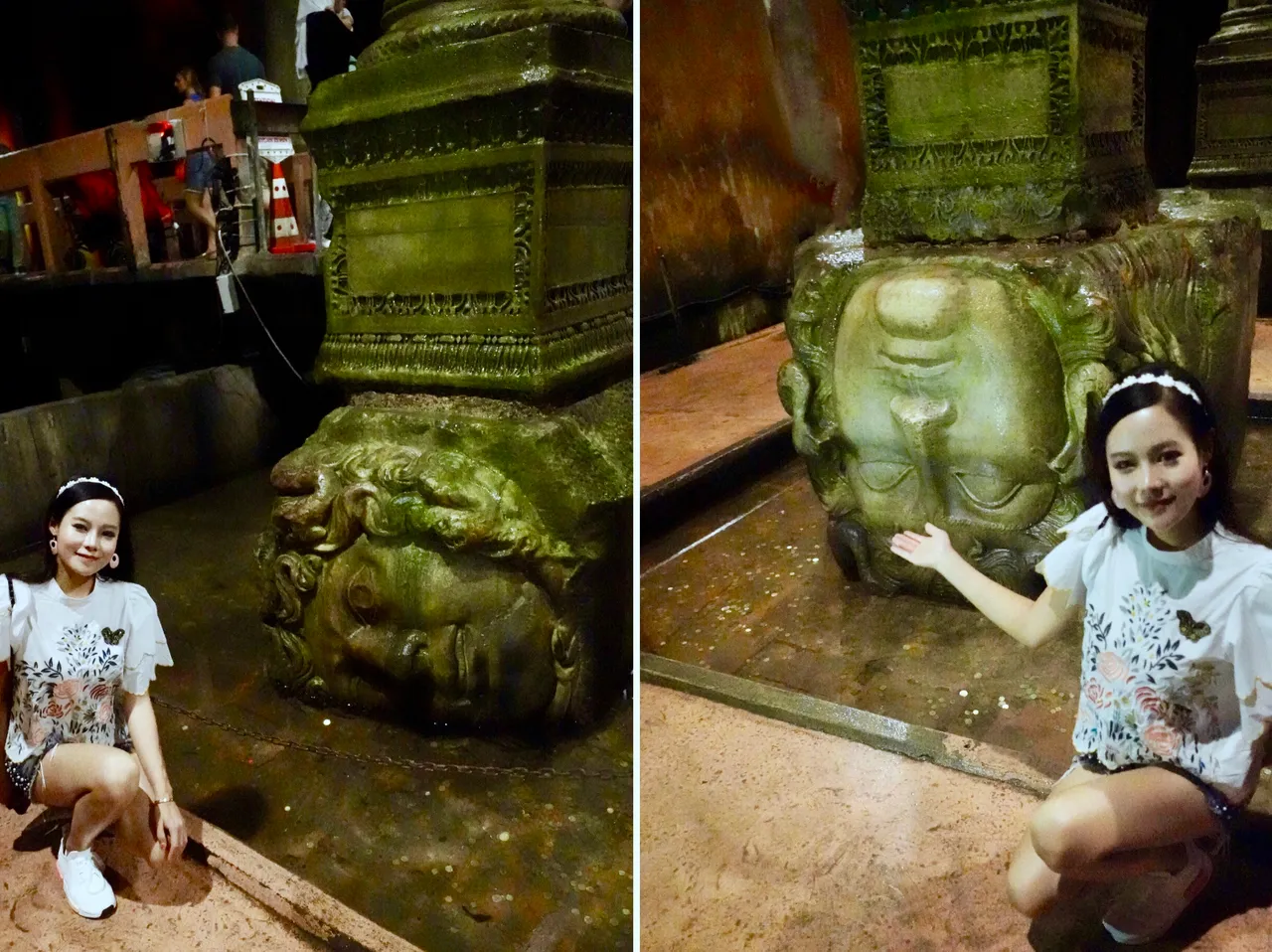
There are two columns in the Basilica Cistern that have been built by re-using existing carved blocks of stone, which have the face of the ancient Greek myth Medusa. Medusa was a woman in Greek mythology whose hair was made of serpents and if you met her stare you would be turned to stone. No one really knows where these block carvings came from but they sure are impressive. Imagine moving such large pieces of stone to this location, underground, with those dangerous eyes looking at you the whole time.

I hope you enjoyed exploring Sultan Ahmed Mosque and Basilica Cistern with me today. The mosque was truly spectacular. I'm still trying to get my head around the beauty, majesty, complexity and sheer size of the interior with its tiled walls and huge chandelier. The cistern had a kind of rugged power from its pure size - deep underground with the low light, the smell of water and the echos of my voice for company. To think of how many thousands took to build it, so many hundreds of years ago, was truly mind blowing.
Have any of you visited this amazing city and these amazing sights? If you have, let me know and I'd love to compare notes! I can't wait to see you all again in my next blog post, so make sure you don't miss it and follow me if you haven't. Have a wonderful day and I'm looking forwards to sharing in another adventure with you soon.



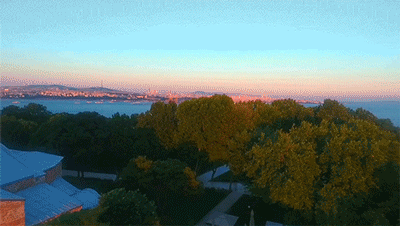
Check out the full video below!
这一段时间,我带大家踏上了星月之国土耳其的土地,走过了许多交织着神秘奇幻色彩的风景,在土耳其的最后一站,我回到了这段旅程最开始的地方,伊斯坦布尔,面对这样一片在历史长河中塑造了独特魅力与韵味的土地,又怎么忍心一笔带过呢?作为土耳其的最大城市,伊斯坦布尔的一座座大桥连接了博斯普鲁斯海峡、金角湾和马尔马拉海的海峡两岸,衔接了欧亚大陆,在这里不仅可以感受到伊斯兰教国家的异域风情,也同样能体会到多文化,古老与现代的融合。现在就让地中海的微风伴随着我们探索的步伐,一起去找寻伊斯坦布尔那些承载了文化与历史的文物古迹景点。
蓝色清真寺
伊斯坦布尔的景点相对比较集中,数量不多但是每一个都很精致,且暗藏着深厚的历史,错过一个仿佛就会错过一个不可思议的新世界,所以就让我们一个个去探个究竟吧。蓝色清真寺就是一个兼具了历史古迹和艺术观赏性的建筑,又叫做苏丹艾哈迈德清真寺,建于1609年至1616年的苏丹艾哈迈德一世统治时期。因为室内砖块全部采用蓝白色系的伊兹尼克瓷砖,所以被人们亲切的称为蓝色清真寺。
远观清真寺的外观设计
作为伊斯坦布尔最重要的标志性建筑,蓝色清真寺有着拜占庭风格的圆顶,周围环绕六根宣礼塔,象征了伊斯兰教的六大信仰。据说,当年建造这座清真寺的时候,并没有使用一根铁钉,却创造了400年间历经无数次大地震却安然无恙的奇迹,没想到外观造型的独特已经令人赞叹,而华丽建筑背后的严谨设计与计算,对于建筑结构的巧妙把握,更令我惊讶不已。其实在这座城市里,像蓝色清真寺这样拥有奇妙结构的异形清真寺建筑还有很多,它们几乎分布在城市的每一处角落,在伊斯坦布尔的路上漫步,仿佛总有一座清真寺在路的尽头威武的矗立着,这些神圣的清真寺好像是列队守护着这座城市,为城市带来和谐与安逸,也为这座城市平添了独特的迷人底蕴。
作为世界十大奇景的蓝色清真寺每年吸引了无数游客前来参观,从上空俯瞰,清真寺被葱葱郁郁的树木包围,6个尖塔高耸入云,格外醒目,听说每座清真寺都不可或缺的尖塔,在这里还有个小传说,相传只有伊斯兰教圣城麦加的清真寺才可以盖六根尖塔,不过在蓝色清真寺兴建的时候,建筑师听从艾哈迈德一世“黄金的”的命令,没想到“黄金的”和“六根的”发音极其想近,这样一个小误会就让蓝色清真寺逾矩成为了唯一拥有六根尖塔的清真寺。
我迫不及待的踏上通往清真寺内部的道路,走过有大理石铺砌而成的大门,就来到了内庭,庭院里站满了入寺参观又不禁驻足欣赏内庭风光的游客,仔细观察可以看到内庭四周均匀分布着30个拱门,修砌庭院用的粉红砾石,大理石还有斑岩的大石柱,非常气派有韵味,加上精细花哨的图案,好像是少女裙摆上的小花边,散发着浪漫唯美的气息。用于洗礼的喷水池占据了内庭中心,从这个角度看过去,前方主殿大大小小、层次分明的圆顶就像起起伏伏的波澜,搭配柔和的色彩,十分梦幻。正当我看的入神,有几位同来参观的朋友过来和我打招呼,看到我身上穿着Steemit的衣服,十分感兴趣,还和我合影留恋。
走入蓝色清真寺
欣赏了许久清真寺外观的美,就引起我更大的兴趣去探索一下砖墙之内的秘密。包好头巾,穿上鞋套,迈入这座可以容纳1万人的清真寺,踩在寺内设计精美豪华、质地柔软的地毯上,清凉的气息扑面而来,给酷热里的浮躁心灵降降温,寺内的游客保持着肃穆安静的气氛,仿佛时间禁止,一同静心享受清真寺内的神秘魅力。
内部的装修让人眼前一亮,不规则的布局显得空间巨大,从内部的视角望过去十分震撼。祈祷殿上方的最大圆顶高达43米,直径23.5米。最吸引我的是清真寺内部奇异的光线变换,从不同的角度所看到的天顶颜色也有不同。整个清真寺内部有着极强的透光性能,源自于这260扇窗户,白天的时候,阳光洒进来可以更清晰的欣赏到每一寸精心设计的小细节,以及那些精致的花边图形彩绘艺术当然也尽收眼底啦。当光线暗下来的时候,整个清真寺内部显得异常神秘和迷人,以花朵一般排列着的吊灯用来辅助照明,泛着丰富多彩的光线,仿佛是一座金碧辉煌的宫殿,那一刻绚丽多姿的画面给我留下了深刻的印象。
另一个让我非常喜爱的特点就是,整座清真寺的墙壁自其三分之一以上全部使用了土耳其瓷器名镇“伊兹尼克镇”烧制的手工陶瓷砖瓦,记忆力好的小伙伴们一定记得我曾经分享过自己对于土耳其陶瓷是多么的着迷,这20000块设计着50种不同款式郁金香(土耳其国花)图案的砖瓦,还有许多华丽的柏树和水果图案款式,以白色为底蓝彩釉贴瓷,精美绝伦的设计真让人爱到抓狂呢。清真寺的开放时间为早上九点到晚上九点,其中会有五次闭门祈祷的时间,游客在教徒们祈祷的30分钟内是不能进去参观的,可见在尽情捕捉恢宏壮观的景色之外,理解并尊重当地的宗教信仰则成为了更重要的命题。
地下水宫殿
在离蓝色清真寺不远的地方,你能找到在这个伊斯坦布尔最古老的苏丹哈美特区,另一个重要的景点,地下水宫殿。在土耳其炽热的烈日之下,最希望的就是找个地方清凉一下,于是这个地下水宫殿就成为了避暑最惬意的选择,现在我们就顺着楼梯走进地下水宫,好好享受一番自带天然冷气的宫殿吧。古老的地下水宫殿面积不大,长约143米,宽约65米,却有着336条石柱,彼此对称而设,构建出这座有着独特韵味的水上宫殿,恢弘的场面让人非常震惊。每一个柱子上面都雕刻着精美的图案,柱子下面打着金色的灯光,映衬着水上的倒影,营造出魔幻的视觉,这座宫殿让我享受了一番唯美的视觉盛宴呢。仔细聆听,还可以听见悠远的滴水声,阅读着关于水宫的诡异传说,还真是仿佛步入一个变幻莫测的异度空间呀。
地下宫殿里有着规模最大的地面蓄水池,这座水上宫殿的历史可以追溯到公元六世纪,由拜占庭皇帝查士丁尼兴建,最早是用于为周围的皇宫和建筑物储水,后来这座水宫历经了被关闭,而后又被重新开发,作为军事弹药库使用,再到作为伊斯坦布尔市民日常饮用水的来源之一。如今这座水宫却成为了众人眼里最浪漫和神秘的旅游景点。其实这座地下水宫殿早在国内的旅游节目《花样姐姐》里就出镜过了,当时李治廷带着众姐姐们在水宫里穿上了土耳其宫廷服饰拍照,这不一走下去,我一眼就望见了正在欣喜拍皇室宫廷照留念的游人们。
要说在整个地下水宫里,让我印象最深刻的就是宫殿西北方这两座由刻有美杜莎面貌的底座支撑起来的石柱,虽然这两座底座的神秘来源至今是个谜,无书面证据也无从考证,所以也不曾有人知道美杜莎雕像被倒置作为石柱底座的缘由,一些学者们猜测头像被倒着放置有可能只是大小刚好适合支撑石柱而已。其实在旅游中我最期待去了解的就是这些神奇的未解之谜,总是给我无限的遐想空间,趣味无穷。
关于希腊神话中可怕的女妖美杜莎,也有着许许多多的传说,美杜莎拥有着可以把看她眼睛的人变成石头的能力,所以她的图像常常被用来保护重要的建筑,所以更有人猜测,倒着放置美杜莎的头像雕塑是不是害怕人们看到她的眼睛而被变成石头呢?今天伊斯坦布尔的历史文化奇幻之旅就要告于段落啦,之后还有更多精彩的旅行故事想要分享给大家!

